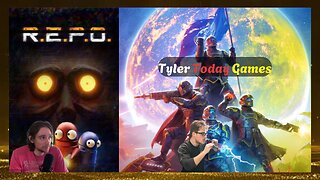Premium Only Content

Doctor Ox's Experiment by Jules Vernes (1872)
"Doctor Ox's Experiment" (French: Une fantaisie du docteur Ox) by Jules Verne, published in 1872, is a short story that combines science fiction with satire. The story explores themes of science gone wrong, social commentary, and human nature, framed through a comedic lens. It's one of Verne’s lighter works compared to his more famous novels, but it still maintains his signature blend of speculative science and imaginative storytelling.
Plot Summary:
The story is set in the quiet, sleepy town of Quiquendone, a fictional Flemish village where everything moves at an incredibly slow pace—people, events, and even emotions are subdued. The calm life of the town’s inhabitants changes dramatically when Doctor Ox, a mysterious and eccentric scientist, proposes to install a new gas lighting system under the guise of improving public lighting. However, his real goal is to conduct a secret experiment on the town's atmosphere.
Unknown to the townspeople, Doctor Ox is pumping oxygen into the air, which begins to affect the citizens’ behavior. As the oxygen levels rise, the previously slow-moving and passive people of Quiquendone become increasingly agitated, emotional, and even violent. Arguments escalate into conflicts, and long-held grievances suddenly boil over, all while Doctor Ox and his assistant Ygène observe the chaotic results of their experiment with detached amusement.
The story reaches its climax when the townspeople are on the verge of war with a neighboring village over a trivial matter. At the last moment, Doctor Ox shuts down his experiment, and the citizens of Quiquendone revert to their usual lethargic selves, completely unaware of what had transpired.
Key Themes:
1. Satire of Science and Experimentation:
Verne pokes fun at the hubris of science, especially when used without ethical considerations. Doctor Ox's experiment is conducted purely out of curiosity, with no regard for the consequences it has on the people he’s experimenting on.
2. Social Commentary:
The story serves as a commentary on how changes in environment, particularly those influenced by science or technology, can drastically alter human behavior. It also explores how quickly people can become irrational and violent when influenced by external forces.
3. Comedic Elements:
Despite the serious themes, Verne uses comedy and satire throughout the story, making fun of the exaggerated slowness of the townspeople and the over-the-top reactions they have once their behavior changes.
4. Human Nature:
Verne reflects on the duality of human nature—how quickly people can shift from calm and composed to chaotic and irrational under the right (or wrong) conditions.
Impact and Style:
"Doctor Ox's Experiment" reflects Verne’s interest in how scientific experiments can impact society, a theme common in his larger works like "Journey to the Center of the Earth" or "Twenty Thousand Leagues Under the Sea". However, it’s unique in its satirical tone, as it leans more toward social critique than speculative adventure. The story also stands out for its lighter and more humorous approach compared to the grand, exploratory themes of his other novels.
This novella may not be as widely recognized as Verne's other works, but it still offers an insightful look into the moral questions surrounding scientific exploration, while providing an entertaining and humorous narrative.
About the Author:
Jules Verne, renowned for his adventure and science fiction novels such as Twenty Thousand Leagues Under the Sea, had various associations with influential groups during his lifetime. While there is some debate and mystery surrounding his connections to fraternal orders and secret societies, here is an overview of his known or alleged associations:
1. Freemasonry:
Jules Verne was a Freemason, initiated into Amiens Lodge, Les Frères Unis (The United Brothers) in 1888. He attained the degree of Master Mason. This association has been confirmed by multiple biographers and Masonic historians.
Some scholars speculate that Masonic symbolism and themes related to Freemasonry appear subtly in his works. These include themes of exploration, progress, and humanity's connection with nature, which align with Masonic principles of enlightenment, knowledge, and discovery.
2. Speculated Rosicrucian Ties:
There is speculation (but no definitive proof) that Verne might have had connections to Rosicrucianism, another secretive, esoteric order. This theory is based on the mystical and symbolic elements in his novels. However, there is no concrete evidence that Verne was formally involved with the Rosicrucians.
3. Influence of Occult and Esoteric Thought:
Verne’s works, especially those that explore hidden knowledge, geography, and mystical realms, have led some researchers to suggest that he had contact with occult or esoteric circles in France during the 19th century. While this has not been definitively proven, Verne’s curiosity about science, philosophy, and the unknown likely brought him into contact with many intellectual and mystical ideas of his time.
-
 1:22:12
1:22:12
Deus Meum Que Jus
28 days agoUnit 731: The Forgotten Asian Auschwitz by: Alistair Rogers, Danielle Dybbro, and Derek Pua
370 -
 2:42:59
2:42:59
TimcastIRL
10 hours agoTrump SLAMS Biden Over Boulder TERROR Attack, Protecting Illegals & Leftists | Timcast IRL
192K54 -
 LIVE
LIVE
TylerTodayNews
4 hours ago $0.02 earnedHorror game with friends! Then fighting the galactic war | REPO & Helldivers 2 | Tyler Today Games
206 watching -
 LIVE
LIVE
TheBeardedBrent
1 hour ago🔴LIVE🔥 | WARZONE | THE CASUAL KING | ROAD TO 50 SUBS!!🔥
155 watching -
 2:57:28
2:57:28
Barry Cunningham
11 hours agoTRUMP WORLD END OF THE DAY NEWS AND SPECIAL GUEST JOHN AMANCHUCKWU!
87.1K74 -
 8:39:34
8:39:34
SpartakusLIVE
12 hours agoSPECIALIST Easter Egg ALL DAY || Duos w/ StevieT
52.6K1 -
 1:14:47
1:14:47
FreshandFit
10 hours agoTop 5 Business Credit Cards
88.9K8 -
 5:32:23
5:32:23
iCheapshot
10 hours ago $2.97 earnedPart 2 of a12cat34dog's Ben and Ed No Rage Quit Challenge!
50.9K -
 1:49:53
1:49:53
Glenn Greenwald
14 hours agoDOGE: Promises vs. Reality; Ukraine's Drone Attacks on Russian Air Bases; Gaza Ceasefire Deal Developments | SYSTEM UPDATE #463
146K99 -
 2:13:34
2:13:34
RiftTV/Slightly Offensive
12 hours agoZelensky Declares WAR on RUSSIA.. Trump FUMING Over Surprise ATTACK | The Rift | Guest: Sarah Stock
78.8K99